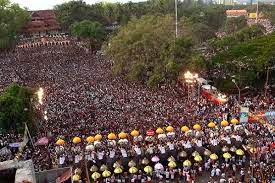Gavi
Gavi is an eco-tourist spot in
Kerala which has widely become poplar after ‘Alistair International’ the world
acclaimed tourism major listed it among the leading eco-tourism centers and one
of the must-see places in India. Drawing
on the wild and natural beauty of the place, the State-run Kerala Forest
Development Corporation has developed an eco-tourism project to attract more
Nature lovers and adventure tourists to the place. It takes a two-hour journey by jeep from Kumily to
reach picturesque Gavi which is blanketed by the greenery of tea plantations.
As Gavi is adjacent to the Periyar
Tiger Reserve, visitors will have to pass through a large area of the reserve
forests. The view of the amazing greenery and a glimpse into the wildlife
are two of the major attractions of the journey. An important landmark en-route is the
Pampa Reservoir. The Pullumedu peak is also on the way.
In Gavi
Cooling off in the waters of
bubbling brooks among thick greenery inhaling the fresh air scented with the
aroma of cardamom is a magical experience that very few places other than Gavi
can offer. The wild animals like the Nilgiri Langurs, the herds of elephants
and the diverse avian fauna make the place all the more attractive.
The picturesque beauty of the place attracts a steady stream of visitors including deep jungle trekkers, bird watchers, Nature lovers, research students, and those looking for a break from the daily grind. If you are the bird watcher, Gavi is the place for you. With more than 260 species of birds including the great pied hornbill, woodpecker and kingfishers. Gavi is a heaven for birdwatchers.
The eco-tourism project have come
up with various activities for visitors including treks in deep jungles,
night safaris, outdoor camping, elephant safaris, wildlife watching,
bird-watching, stays a top tree huts, visits to Paradise Cove at Ninnumulli,
boating in Gavi and Kochupampa lakes, stays at the eco-lodge overlooking Gavi
Lake, leisurely walks through spice gardens, visits to cardamom factories and
so on.
Meenar offers tranquil and pristine natural beauty while the Chenthamara Kokka offers a scenic view of the dangerously alluring deep ravine with thick forests below.
Meenar offers tranquil and pristine natural beauty while the Chenthamara Kokka offers a scenic view of the dangerously alluring deep ravine with thick forests below.
A boat-ride across Paradise Cove
at Ninnumulli is another magnificent experience. The cove has many exquisite
wild flowers and one can also hear the musical chirping of birds in the
backdrop.
A splendid spot to be visited at
least once for all those who love nature.
































